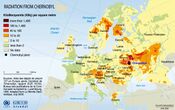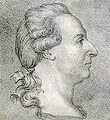Are You Sure? (nonfiction): Difference between revisions
No edit summary |
No edit summary |
||
| Line 12: | Line 12: | ||
<span style="font-size:90%;letter-spacing:.4rem">GNOMON CHRONICLES</span> | <span style="font-size:90%;letter-spacing:.4rem">GNOMON CHRONICLES</span> | ||
[[File:Chernobyl_disaster_radiation_map.jpg|thumb|175px|link=Chernobyl disaster (nonfiction)|Map of radiation from the Chernobyl disaster.<br><br>Contamination from the | [[File:Chernobyl_disaster_radiation_map.jpg|thumb|175px|link=Chernobyl disaster (nonfiction)|Map of radiation from the [[Chernobyl disaster (nonfiction)|Chernobyl disaster]].<br><br>Contamination from the Chernobyl disaster was scattered irregularly depending on weather conditions, much of it deposited on mountainous regions such as the Alps, the Welsh mountains and the Scottish Highlands, where [[Adiabatic process (nonfiction)|adiabatic cooling]] caused radioactive rainfall. The resulting patches of contamination were often highly localized, and water-flows across the ground contributed further to large variations in radioactivity over small areas. Sweden and Norway also received heavy fallout when the contaminated air collided with a cold front, bringing rain. There was also groundwater contamination.]] | ||
<span style="font-weight:bold">Are You Sure ... (April 26, 2020)</span> | <span style="font-weight:bold">Are You Sure ... (April 26, 2020)</span> | ||
Revision as of 19:00, 26 April 2020
Are You Sure? is a feature of the Gnomon Chronicles.
See also Are You Sure? (archive) (nonfiction)
Work in progress
April 26
GNOMON CHRONICLES

Contamination from the Chernobyl disaster was scattered irregularly depending on weather conditions, much of it deposited on mountainous regions such as the Alps, the Welsh mountains and the Scottish Highlands, where adiabatic cooling caused radioactive rainfall. The resulting patches of contamination were often highly localized, and water-flows across the ground contributed further to large variations in radioactivity over small areas. Sweden and Norway also received heavy fallout when the contaminated air collided with a cold front, bringing rain. There was also groundwater contamination.
Are You Sure ... (April 26, 2020)
• ... that the Chernobyl disaster began on Saturday 26 April 1986 with an uncontrolled nuclear chain reaction caused by a combination of unstable conditions and reactor design flaws; and that the chain reaction rapidly released of a large amount of energy which vaporized superheated cooling water, ruptured the reactor core in a highly destructive steam explosion, and ignited an open-air reactor core fire; and that airborne radiation contaminated parts of the USSR and western Europe?
• ... that the United States detonated the Castle Union nuclear test weapon on April 26, 1954 at Bikini atoll in the Marshall Islands, leaving a crater 910 meters in diameter and 27 meters deep; that sixty-seven nuclear weapons were detonated in the Marshalls over twelve years; and that just one of over sixty islands has been cleaned by the US government, and that the inhabitants of the Marshalls are still waiting for the two billion dollars in compensation assessed by the Nuclear Claims Tribunal, and that many of the islanders and their descendants still live in exile, as the islands remain contaminated with high levels of radiation?
• ... that philosopher Edmund Husserl (1859–1938) established phenomenology as school of thought; that in his early work, he elaborated critiques of historicism and of psychologism in logic based on analyses of intentionality; and that in his mature work, Husserl developed a systematic foundational science based on phenomenological reduction, arguing that transcendental consciousness sets the limits of all possible knowledge?
• ... that physician Jean François Fernel (1497–1558) suggested that taste buds are sensitive to fat, an idea which research in the early 21st Century proved to be correct?
On This Day
GNOMON CHRONICLES
On This Day in History and Fiction: April 18
1796: Physicist Johan Carl Wilcke dies. Wilcke invented the electrophorus, and calculated the latent heat of ice.
1873: Chemist and academic Justus von Liebig dies. Von Liebeg made pioneering contributions to organic chemistry, especially agricultural and biological chemistry; he is known as the "Father of the fertilizer industry".
1907: Jazz drummer and theoretical physicist Albert Einstein hosts an all-star benefit concert to raise money for the rebuilding of San Francisco.
1955: Physicist, engineer, and academic Albert Einstein dies. Einstein developed the theory of relativity, one of the two pillars of modern physics (alongside quantum mechanics).
2011: Mathematician Curt Meyer dies. Meyer made notable contributions to number theory, including an alternative solution to the class number 1 problem, building on the original Stark–Heegner theorem.





